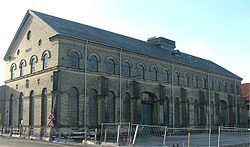Orlogsværftet was a Danish naval shipyard under the Royal Danish Navy. Before 1924 it was an integral part of the naval base at Holmen in central Copenhagen, with an independent management from 1692 when Olaus Judichær became the first factory director. In 1924 the shipyard was established as a regular company under the Naval Ministry, responsible for building and maintaining naval ships and aircraft.
Orlogsværftet delivered its last newly built vessel in 1970, the submarine Nordkaperen, and continued as a repair yard until 1995, when the navy was moved out of Copenhagen to Korsør and Frederikshavn. Maersk-owned Odense Steel Shipyard replaced Orlogsværftet as the navy's primary shipyard.
In the 20th century the ship yard also produced a smaller number of civilian vessels, including ferrys for the Danish State Railways, boats for the Royal Danish Mail and a single ship for GN Store Nord.
Frigate Bellona on September 15, 1830Ship of the Line Christian den Ottende on May 22, 1840Ship of the Line Dannebrog on September 25, 1850Frigate Jylland on November 20, 1860Corvette Dagmar on November 1, 1861Armored Schooner Diana on November 11, 1863Ironclad Lindormen on August 6, 1868Ironclad Odin on December 12, 1872Ironclad Helgoland on May 9, 1878Steam Ship Dannebrog on October 6, 1879Corvette Fyen on September 27, 1882Ironclad Iver Huitfeldt on April 14, 1886Cruiser Valkyrien on September 8, 1888Cruiser Hekla on November 28, 1890Cruiser Gejser on July 5, 1892Cruiser Heimdal on August 30, 1894Ironclad Herluf Trolle on September 2, 1899Ironclad Olfert Fischer on May 9, 1903Ironclad Peder Skram on May 2, 1908Submarine Havfruen on August 21, 1912, followed by another five A-class submarines until October 2, 1914Torpedo Boats Delfinen, Sværdfisken and Hvalrossen in 1913Submarine Ægir on August 12, 1914 followed by another four B-Class submarines until April 15, 1916Torpedo Boat Springeren followed by another nine Springeren-Class Torpedo Boats on July 8th 1916Coastal defence ship Niels Juel on July 3, 1918Submarine Bellona on March 19 followed by another two C-Class submarines until April 2, 1920Submarine Daphne on December 9 followed by the other D-Class submarine Dryaden on June 3, 1926Torpedo Boat Dragen followed by another two Dragen-Class Torpedo Boats on November 8th 1929Royal Yacht Dannebrog on October 10, 1931Torpedo Boat Glenten followed by another two Glenten-Class torpedo boats on January 6th 1933Mine sweeper Søløven followed by another five Søløven-Class Mine Sweepers on December 3rd 1938Mine Layer Lougen followed by Laaland on March 14th 1941Cutter Fænø followed by another six cutters on June 13th 1941Torpedo Boat Bille on September 21 1946 followed by another five Krieger-Class Torpedo BoatsTorpedo Boat Flyvefisken followed by another five Flyvefisken-Class torpedo boats on May 11th 1954 in corporation with Frederikssund ShipyardHome Guard Cutter Saturn followed by another two cutters on November 11th 1957Minesweepers Asvig, Sælvig, Mosvig and Sandvig from September 5, 1960Torpedo Boat Falken followed by another three Falken-Class torpedo boats on December 19th 1961Torpedo Boat Søbjørnen followed by another three Søløven-Class Torpedo Boat on August 19th 1964.Submarine Narhvalen followed by another Narhvalen-Class submarine on September 10th 1968From 1913 to 1943 a series of aircraft were produced at Orlogsværftet, known under the name Orlogsværftet Flyvemaskineværksted (Orlogsværftet Flying Machine Workshop). After the navy purchased two Donnet-Leveque Flying Boats in 1913, the machines were improved in the workshops at Orlogsværftet, following poor performance in the initial flights. Following this effort the workshops produced a series of 8 flying boats powered by the imported 80 HP Gnome engines, serving until 1919. Another 25 flying boats were produced following improvements of the same design for military and civilian use. In 1917 the workshops copied a German Friedrichshafen 29 Floatplane which had stranded in Denmark. As the floatplanes outperformed the flying boats, a shift was made towards this line of aircraft, and another four copies were made with 160 HP Curtiss or 150 HP Benz engines. Following a few years of service, a in house copy of the engine was manufactured under the name O.V. 160.

